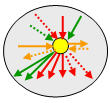People come in bringing a unique set of skills, knowledge, experience, and social networks. They join an organization in a job that includes a membership and positional role in a management team and, increasingly often, additional roles in multiple teams.
People may move in and out of teams as part of their position’s responsibilities, and they may move on to another position within the organization. Positions get changed by their actors, are changed by their managers, and are created or eliminated by the management decision-making structure, all of which effect the teams where that job functioned. Eventually, people leave, taking their intimate knowledge with them, unless the organization through its teams has somehow absorbed and retained that knowledge.
For the person, for me, leaving knowledge behind does not diminish my knowledge carried away. Indeed, it increases it. I am more aware of what I know because the essence of it has been made explicit for my team mates and, eventually, the organization. The laws of information prescribe that knowledge accumulates with use (plenty). The laws of physics prescribe that material things diminish with use (scarcity). Higher levels of organizational intelligence emerge from the vastly expanded human capacity to retain, link, and use knowledge governed by information laws of plenty.


